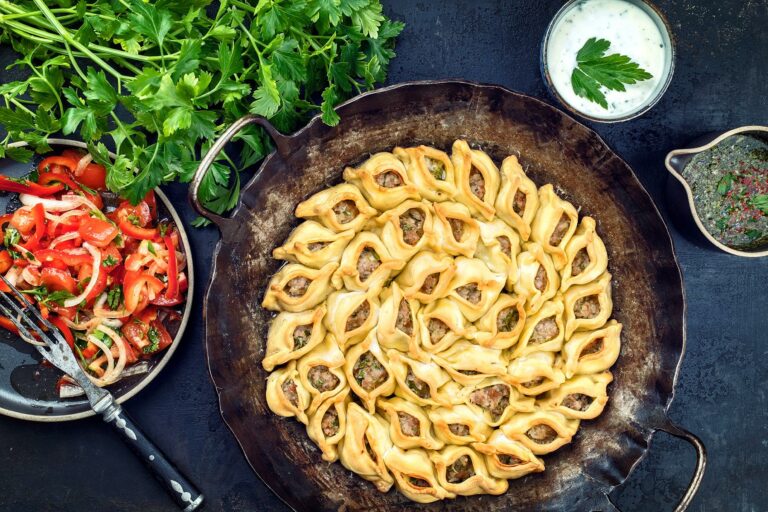Introduction: What is Armenian cuisine?
Armenian cuisine is the traditional cuisine of the Armenian people, which is characterized by its rich and vibrant flavors, exotic spices, and diverse ingredients. The cuisine is known for its blend of different cultures, as it has been influenced by the Mediterranean, Middle Eastern, and Eastern European cuisines over the centuries.
Armenian cuisine is a fusion of different cooking styles and techniques, ranging from grilled meats and poultry to savory stews, soups, and grilled vegetables. The cuisine also includes a variety of dairy products, such as cheeses and yogurt, as well as a range of breads and pastries.
Historical influences on Armenian cuisine
Armenian cuisine has been influenced by a range of cultures and historical events, including the Byzantine Empire, the Mongol Empire, the Ottoman Empire, and the Russian Empire. These influences have resulted in a unique blend of flavors and ingredients that are specific to Armenian cuisine.
The cuisine has also been shaped by the geography and climate of Armenia, with the mountainous terrain and harsh winters influencing the array of ingredients used in traditional dishes. The region’s access to the Black Sea and the Mediterranean has also provided a source of fresh seafood and spices that have made their way into Armenian cuisine.
Ingredients and flavors unique to Armenian cuisine
One of the unique features of Armenian cuisine is the use of exotic spices and herbs, such as saffron, sumac, and mint, which are used to add flavor and aroma to traditional dishes. The cuisine also makes use of a range of fruits and vegetables that are specific to the region, including pomegranates, apricots, and eggplants.
Other key ingredients in Armenian cuisine include lamb, beef, and chicken, which are often grilled or roasted and served with a range of sides, including rice, bulgur, and lentils. The cuisine also includes a range of dairy products, such as cheeses and yogurt, that are used to add richness and creaminess to dishes.
Popular Armenian dishes and their origins
Some of the most popular Armenian dishes include kebab, dolma, and pilaf. Kebab is a dish made from grilled meat that can be served with a range of sides, while dolma is a stuffed grape leaf dish that can be filled with a range of ingredients, including rice, vegetables, and meat. Pilaf is a dish made from rice that is cooked with a variety of spices and ingredients, such as lamb, chicken, or vegetables.
Many of these dishes are believed to have originated in the Ottoman Empire, which ruled over Armenia for several centuries. However, others have their roots in ancient Armenian cuisine, which was heavily influenced by the Persians and Greeks.
Comparing and contrasting Armenian cuisine with Middle Eastern cuisines
While Armenian cuisine shares some similarities with Middle Eastern cuisines, such as Lebanese and Syrian cuisine, it also has some distinct differences. For example, Armenian cuisine makes greater use of dairy products, such as cheeses and yogurt, while Middle Eastern cuisine tends to focus more on grilled meats and vegetables.
Armenian cuisine also uses a wider range of spices and herbs than Middle Eastern cuisine, which tends to be more focused on the use of aromatic spices like cumin and coriander. Additionally, Armenian cuisine makes greater use of fruits and vegetables that are specific to the region, such as pomegranates and eggplants.
Cuisine similarities and differences with Armenian neighbors
Armenian cuisine shares similarities with its neighbors, including Georgian and Turkish cuisine. These cuisines also use a range of spices and herbs, and make use of grilled meats and vegetables.
However, Armenian cuisine differs in its use of dairy products and specific ingredients like pomegranates, which are not as prominent in Georgian and Turkish cuisine. Armenian cuisine also has a greater focus on breads and pastries, which are a staple in the Armenian diet.
How Armenian cuisine has evolved over time
Armenian cuisine has evolved over time, in response to a range of historical events and cultural influences. For example, during the Soviet era, many traditional Armenian dishes were modified or eliminated to fit with Soviet dietary guidelines.
However, in recent years, there has been a renewed focus on traditional Armenian cuisine, with efforts to preserve and promote the cuisine through festivals and cultural events. This has led to a resurgence of interest in Armenian cuisine, both within Armenia and around the world.
Conclusion: The future of Armenian cuisine and its significance
Armenian cuisine is a unique and vibrant cuisine that has been shaped by a range of cultural influences over the centuries. While the cuisine has faced challenges in the past, there is a renewed interest in preserving and promoting traditional Armenian dishes, both within Armenia and around the world.
As Armenian cuisine continues to evolve and adapt, it will remain an important part of the country’s cultural heritage and a reflection of its rich and diverse history.

